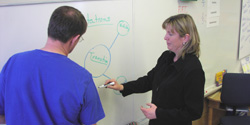

Teaching Thinking
Teaching and Learning Strategies
Classroom Examples of Teaching and Assessing Thinking
Improving Learners ’ Thinking
Schools have always been places where learners were supposed to learn to think. In simpler times, computational and reasoning skills were sufficient to ensure success in future schooling and life. The 21st Century demands more of its citizens. Today, basic skills are likely to be performed by computers, and today’s learners will be called upon to understand and use more and more information in increasingly complex and subtle ways on the job, as well as in their civic and personal lives.
Creating a Thoughtful Classroom Environment >
In thoughtful classrooms, talk about thinking is part of every subject / learning area and every lesson. There is no, “Okay, now we’ll do our thinking lesson.” Instead there is, “Now we’re going to think scientifically,” and “Now we’re going to think like authors.”
Conversations about thinking should happen at every grade level. As early as Foundation and Intermediate Phase, teachers can use terminology related to thinking. “What point of view’ might the wolf have?” or “What ‘evidence’ do you see that the plants in sunlight are growing faster than those in the dark?” Older learners can be expected to elaborate answers, reconcile contradictions, and analyze the point of view of supposedly objective information.
Explicit Teaching in Thinking Skills and Strategies >
Many conscientious teachers, aware of the importance of teaching learners to think, have organized their teaching around complex projects that require learners to make decisions and solve problems. Certainly, some learners can develop higher-order thinking skills indirectly with this method. Research is clear, however, that mere exposure to tasks that require thinking does not on its own have a significant impact on learners’ thinking abilities (Beyer, 2000, Swartz, 2000). Those skills can be taught through modelling, guided practice, and training.
Assessing Thinking >
Creating a thoughtful classroom isn’t easy. It demands creative, thinking teachers who can identify the kinds of thinking skills required in a particular project, assess their learners’ proficiency at those skills, and design instruction that moves them forward to higher levels of thinking. It also requires teachers who can use their own thinking as an experimental stage for helping their learners by thinking about their own thinking and examining their own assumptions about teaching, learning, and assessment.
In many classrooms, learners’ thinking is assessed solely on the basis of the products of that thinking. In the case of multiple-choice and true-false questions, we assumed that if learners came up with the right answer, they were using good thinking strategies, but we know now that this is not always the case. The challenge is, of course, how to assess a process that goes on primarily inside the brain. Fortunately, many thinking processes leave traces behind, traces that not only help a teacher understand how a learner is thinking, but also help learners grow as thinkers. By looking at the artifacts of learners’ thinking, such as discussions, graphic organizers, and notes, teachers can learn a great deal about the thinking processes of their learners and use that information to make good decisions about individual and group facilitation.
References
Beyer, B. K. (2000). Teaching thinking skills—Defining the problem. In A. L. Costa (Ed.), Developing minds: A resource book for teaching thinking, (pp. 35-40). Alexandria VA: ASCD.
Kincheloe, J. L. (2000). Making critical thinking critical. In D. W. Weil and H. K. Anderson (Eds.), Perspectives in critical thinking: Essays by teachers in theory and practice, (pp. 23-37). New York: Peter Lang.
Perkins, David. (1995). Smart schools: Better thinking and learning for every child. New York: Free Press.
Swartz, R. J. (2000). Thinking about Decisions. In A. L. Costa (Ed.), Developing minds: A resource book for teaching thinking, (pp. 58-66). Alexandria VA: ASCD.
